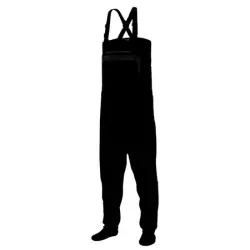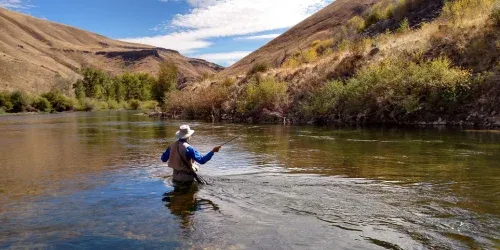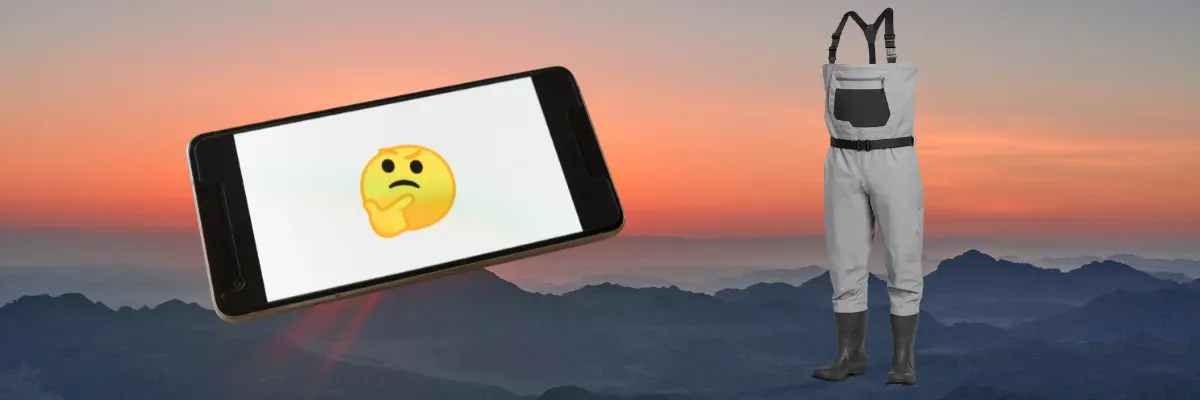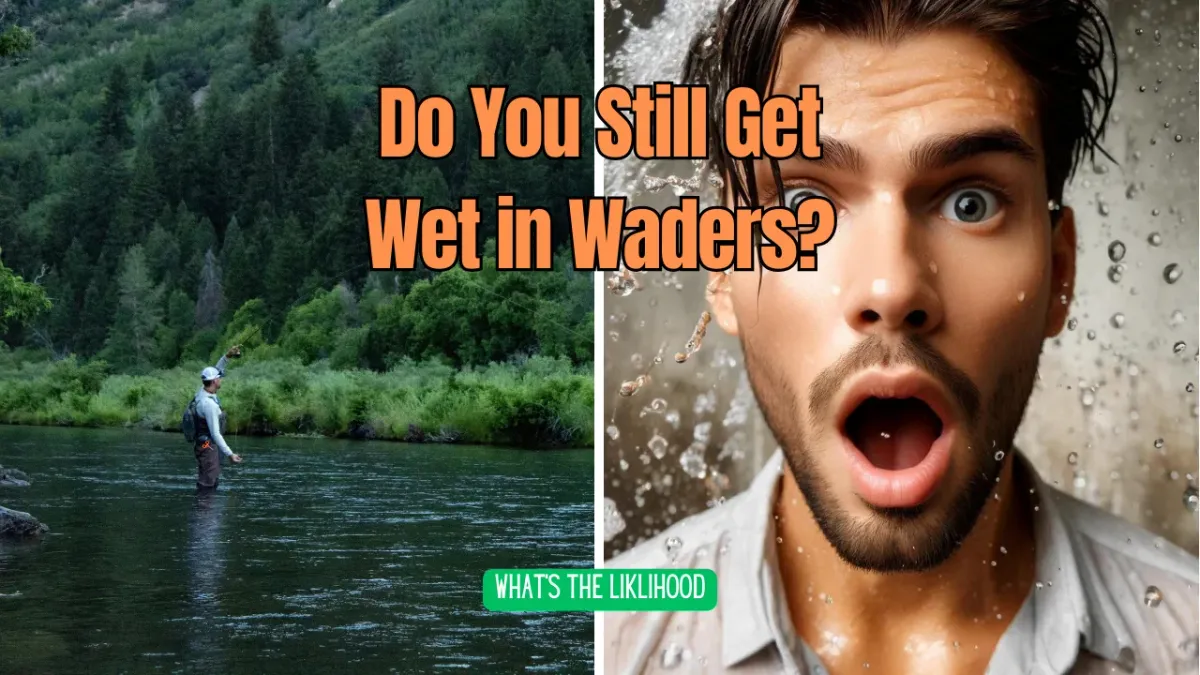When it comes to fly fishing or any water-based activity, the question often arises: "Do you wear shoes with chest waders?" This query might seem straightforward, but the answer involves a bit of nuance. Whether you're a seasoned angler or a novice just dipping your toes into the sport, understanding the importance of proper footwear can make a world of difference. Let's dive into the nitty-gritty of why and how you should wear shoes with chest waders.
Key Takeaways:
- Understanding the Necessity: Wearing shoes with chest waders is essential for safety, comfort, and performance.
- Choosing the Right Footwear: Different types of wading boots and shoes offer various benefits depending on the environment and activity.
- Practical Tips: Learn how to select and maintain your wading footwear for optimal use.

The Basics of Chest Waders
Chest waders are a staple for many anglers and outdoor enthusiasts. They are designed to keep you dry while you wade through water, whether you're fishing, hunting, or simply exploring. Chest waders come in various materials, including neoprene and breathable fabrics, each offering different levels of insulation and comfort.
Neoprene chest waders are excellent for cold weather conditions. They provide insulation and keep you warm even in icy waters. On the other hand, breathable waders are ideal for warmer climates. They allow moisture to escape, keeping you dry and comfortable during long hours of activity. Regardless of the type, wearing the right footwear with your chest waders is crucial for safety and performance.

Why You Need Shoes with Chest Waders
Wearing shoes with chest waders is not just a matter of comfort; it's a safety imperative. The primary reason is traction. Water bodies often have slippery rocks and uneven surfaces that can be hazardous. Wading boots or shoes with good grip can prevent slips and falls, ensuring you stay upright and safe.
Another reason is protection. Chest waders, especially stocking foot waders, require an additional layer of protection for your feet. Wading boots provide this protection, shielding your feet from sharp objects, cold water, and other potential hazards. They also offer ankle support, which is essential when walking on uneven terrain.
Types of Wading Boots
When it comes to choosing the right footwear, you have several options. Wading boots are the most common choice. They come in various styles, including felt soles and rubber soles. Felt soles offer excellent grip on slippery rocks, making them ideal for wet wading. However, they can be less effective in muddy conditions.
Rubber soles, on the other hand, provide good traction in a variety of environments. They are also easier to clean, reducing the risk of spreading invasive species. Some wading boots come with metal studs for added grip, which can be particularly useful in fast-flowing rivers.
Stocking Foot vs. Boot Foot Waders
Stocking foot waders and boot foot waders each have their pros and cons. Stocking foot waders come with neoprene stocking feet, requiring you to wear separate wading boots. This setup offers more flexibility and better fit, as you can choose boots that suit your needs.
Boot foot waders, however, have boots attached directly to the waders. This can be more convenient, as you don't need to buy separate boots. However, they can be bulkier and less flexible, making them less ideal for long hikes or challenging terrains.
The Role of Socks
Socks play a crucial role in your wading setup. Neoprene socks are a popular choice for their insulating properties. They keep your feet warm in cold water and provide a snug fit inside your wading boots. Wool socks are another excellent option, especially in cold weather. They offer warmth and moisture-wicking properties, keeping your feet dry and comfortable.
In warmer conditions, you might opt for thinner, breathable socks. These help prevent overheating and keep your feet dry. Regardless of the type, always ensure your socks fit well and don't bunch up, as this can cause discomfort and blisters.
Practical Tips for Choosing Wading Footwear
When selecting wading boots or shoes, consider the environment you'll be in. For rocky rivers, felt soles or rubber soles with metal studs are ideal. They provide the necessary grip to navigate slippery surfaces. In muddy or sandy conditions, rubber soles are a better choice as they offer good traction and are easier to clean.
Fit is another crucial factor. Your wading boots should fit snugly but not too tight. They should accommodate your socks and any additional layers you might wear, such as neoprene booties. Always try on your boots with the socks and waders you plan to use to ensure a proper fit.
Maintaining Your Wading Footwear
Proper maintenance of your wading footwear can extend its lifespan and ensure optimal performance. After each use, rinse your boots and waders with fresh water to remove any dirt, sand, or salt. This helps prevent wear and tear and reduces the risk of spreading invasive species.
Allow your boots and waders to dry thoroughly before storing them. This prevents mold and mildew, which can damage the materials. Store them in a cool, dry place away from direct sunlight to avoid UV damage. Regularly inspect your boots and waders for any signs of wear or damage and repair them promptly to maintain their effectiveness.
Case Study: The Importance of Proper Footwear
John, an avid fly fisherman, learned the hard way about the importance of proper footwear. On a chilly morning in early spring, he set out for a day of fishing in his favorite river. He wore his old pair of waders and decided to skip the wading boots, thinking his neoprene socks would suffice.
As he navigated the slippery rocks, he lost his footing and fell into the cold water. Not only did he get soaked, but he also injured his ankle. This incident could have been avoided with the right pair of wading boots, providing the necessary grip and ankle support.
The Benefits of Wading Shoes
Wading shoes are another option for those who prefer a lighter, more flexible alternative to wading boots. They are designed to offer good traction and protection while being less bulky. Wading shoes are ideal for wet wading in warmer conditions, where you don't need the insulation of wading boots.
They are also a great choice for activities like kayaking or hiking, where you need a versatile shoe that can handle both wet and dry conditions. Wading shoes often come with features like quick-drying materials and drainage holes, making them practical for various outdoor activities.
The Role of Neoprene Booties
Neoprene booties are a valuable addition to your wading gear, especially in cold water conditions. They provide an extra layer of insulation, keeping your feet warm and comfortable. Neoprene booties are also useful for wet wading, offering protection and grip without the bulk of wading boots.
When using neoprene booties, it's essential to choose the right size. They should fit snugly but not too tight, allowing for a comfortable fit inside your wading boots or shoes. Pairing them with the right socks can enhance their insulating properties and ensure a comfortable experience.
The Importance of Ankle Support
Ankle support is a critical factor when choosing wading footwear. Walking on uneven, slippery surfaces can put a lot of strain on your ankles. Wading boots with good ankle support can prevent injuries and provide stability, allowing you to move confidently through the water.
Look for boots with a high-cut design and sturdy construction. Some boots come with additional features like padded collars and reinforced heels, offering extra support and comfort. Investing in a good pair of wading boots with proper ankle support can make a significant difference in your overall experience.
The Role of Traction
Traction is one of the most important aspects of wading footwear. Slippery rocks and uneven surfaces can be hazardous, making good traction essential for safety. Felt soles are known for their excellent grip on wet, slippery surfaces, making them a popular choice for many anglers.
However, felt soles can be less effective in muddy or sandy conditions. Rubber soles offer a versatile alternative, providing good traction in various environments. Some wading boots come with metal studs or cleats, offering additional grip on challenging surfaces. Choosing the right sole for your environment can enhance your safety and performance.
The Benefits of Breathable Waders
Breathable waders are a popular choice for their comfort and versatility. Made from materials like Gore-Tex, they allow moisture to escape while keeping water out. This makes them ideal for long hours of activity, as they prevent overheating and keep you dry.
Breathable waders are also lightweight and flexible, making them comfortable to wear. They are suitable for a variety of conditions, from warm summer days to cooler fall weather. Pairing them with the right wading boots and socks can enhance their performance and ensure a comfortable experience.
The Role of Insulation
Insulation is a crucial factor when choosing wading gear, especially in cold weather conditions. Neoprene waders are known for their insulating properties, keeping you warm even in icy waters. Pairing them with neoprene socks or booties can enhance their insulation and provide additional warmth.
In warmer conditions, breathable waders are a better choice. They offer comfort and flexibility without the bulk of neoprene. Layering with the right base layers, such as long underwear or long johns, can provide additional warmth and comfort. Choosing the right insulation for your environment can ensure a comfortable and enjoyable experience.
The Importance of Fit
Fit is a critical factor when choosing wading gear. Your wading boots and waders should fit snugly but not too tight. They should accommodate your socks and any additional layers you might wear, such as neoprene booties. A proper fit ensures comfort and prevents blisters and discomfort.
When trying on wading boots, wear the socks and waders you plan to use. This ensures a proper fit and allows you to make any necessary adjustments. Look for boots with adjustable features, such as laces or straps, to customize the fit to your needs. Investing in well-fitting gear can enhance your comfort and performance.
The Role of Materials
The materials used in wading gear play a significant role in their performance and durability. Neoprene is known for its insulating properties, making it ideal for cold weather conditions. Breathable fabrics, such as Gore-Tex, offer comfort and flexibility, making them suitable for a variety of conditions.
Rubber soles provide good traction and are easy to clean, making them a versatile choice for various environments. Felt soles offer excellent grip on slippery surfaces but can be less effective in muddy conditions. Choosing the right materials for your environment can enhance your safety and performance.
The Benefits of Layering
Layering is a practical approach to staying comfortable in various conditions. In cold weather, layering with long underwear or long johns can provide additional warmth. Neoprene socks or booties offer insulation and protection, keeping your feet warm and comfortable.
In warmer conditions, lighter, breathable layers are a better choice. They prevent overheating and keep you dry. Layering allows you to adjust your clothing to the conditions, ensuring comfort and flexibility. Choosing the right layers for your environment can enhance your overall experience.
The Role of Maintenance
Proper maintenance of your wading gear can extend its lifespan and ensure optimal performance. After each use, rinse your boots and waders with fresh water to remove any dirt, sand, or salt. This helps prevent wear and tear and reduces the risk of spreading invasive species.
Allow your boots and waders to dry thoroughly before storing them. This prevents mold and mildew, which can damage the materials. Store them in a cool, dry place away from direct sunlight to avoid UV damage. Regularly inspect your boots and waders for any signs of wear or damage and repair them promptly to maintain their effectiveness.
The Importance of Safety
Safety is a critical factor when choosing wading gear. Proper footwear with good traction and ankle support can prevent slips and falls, ensuring you stay upright and safe. Wearing the right layers and insulation can protect you from cold water and harsh conditions.
Always be aware of your surroundings and the conditions you're in. Fast-flowing rivers and slippery rocks can be hazardous, making proper gear essential for safety. Investing in high-quality wading gear and taking the necessary precautions can ensure a safe and enjoyable experience.
The Role of Comfort
Comfort is a crucial factor when choosing wading gear. Properly fitting boots and waders, along with the right socks and layers, can enhance your comfort and prevent blisters and discomfort. Breathable materials and good insulation can keep you comfortable in various conditions.
Look for gear with adjustable features, such as laces or straps, to customize the fit to your needs. Investing in high-quality, comfortable gear can enhance your overall experience and allow you to focus on your activity without distractions.
The Benefits of Versatility
Versatility is a valuable feature in wading gear. Wading boots and shoes that can handle various conditions and activities offer more flexibility and convenience. Breathable waders and lightweight, quick-drying shoes are ideal for a variety of environments, from warm summer days to cooler fall weather.
Versatile gear allows you to adapt to changing conditions and activities, ensuring comfort and performance. Investing in high-quality, versatile gear can enhance your overall experience and provide more value for your investment.

Summary
Wearing shoes with chest waders is essential for safety, comfort, and performance. Whether you choose wading boots, wading shoes, or neoprene booties, the right footwear can make a significant difference in your overall experience. Consider factors like traction, fit, insulation, and materials when selecting your gear. Proper maintenance and layering can enhance the lifespan and performance of your wading gear. Investing in high-quality, versatile gear can ensure a safe, comfortable, and enjoyable experience in various conditions.

FAQs
Do you need special shoes for chest waders?
Yes, wearing special shoes like wading boots or wading shoes with chest waders is essential for safety and comfort. They provide traction, protection, and support, ensuring a better experience.
Can you wear regular shoes with chest waders?
Regular shoes are not recommended with chest waders. They lack the necessary traction and support needed for slippery and uneven surfaces. Wading boots or shoes are specifically designed for these conditions.
What type of socks should you wear with chest waders?
Neoprene socks are ideal for cold water conditions, offering insulation and a snug fit. Wool socks are also a good choice for their warmth and moisture-wicking properties. In warmer conditions, thinner, breathable socks are recommended.
Related articles:











